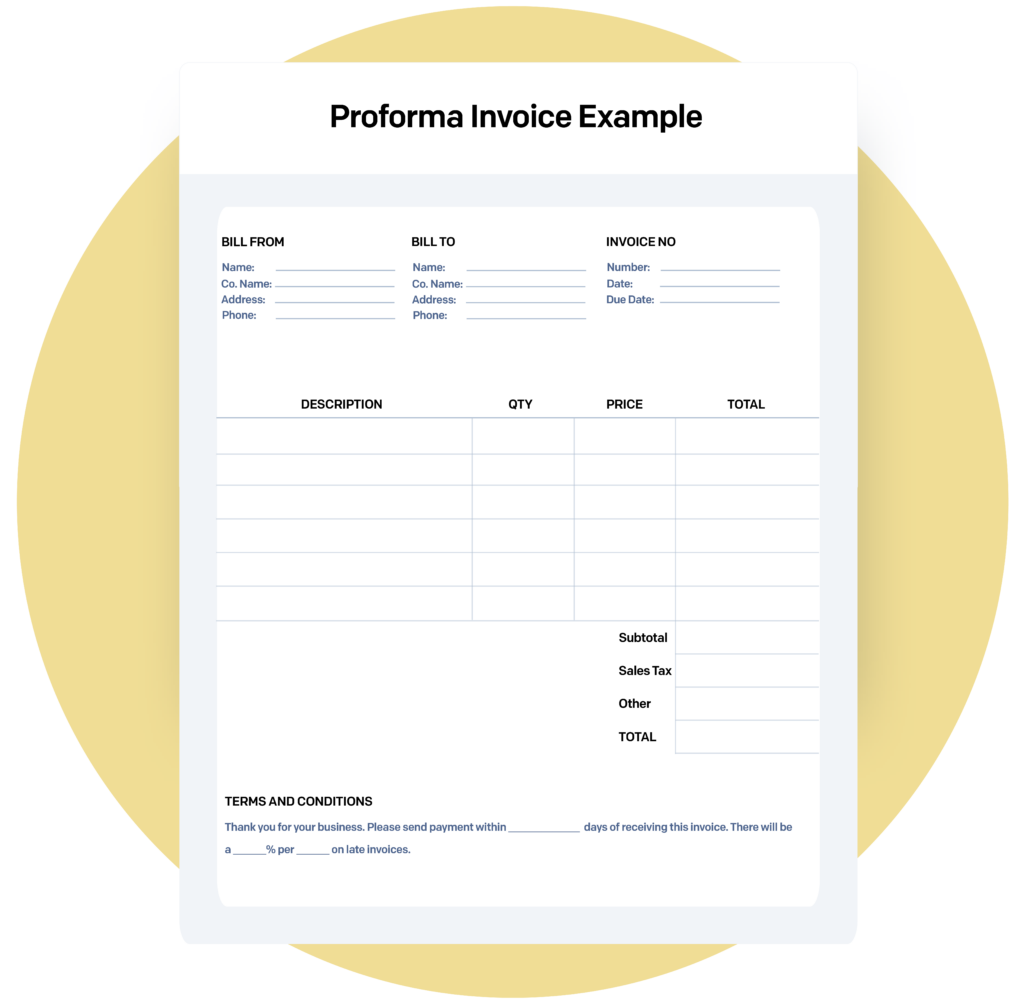Pro forma documents describe the anticipated details of an impending sale and are delivered to buyers before product or service delivery — and sometimes even before manufacturing. As such, these invoices can remove the element of surprise from your sales efforts and help your business avoid stress. Here’s what you need to know about pro forma invoices and what they mean for your business.
Automated invoicing with Invoiced
Talk to an accounts receivable expert about automating your A/R processes
Pro forma invoice meaning
Pro forma is a Latin phrase that translates to “as a matter of form” or “for the sake of the form.” When this descriptor is applied to documents, it typically indicates that the corresponding paperwork is unofficial but was prepared in the same manner or style as official paperwork. It’s essentially a rough draft of documents to come.
So rather than a payment request — like a traditional invoice — a pro forma invoice serves roughly the same function as a purchase order confirmation. It describes the overall order and outlines projected pricing and payment terms with the expected delivery terms and costs clearly outlined. Each party on either side of the transaction knows what to expect from the sale. And if they aren’t happy with the conditions, they can renegotiate before any work starts.
What is included in a pro forma invoice?
A pro forma invoice will frequently appear similar to the final invoice that a business might send, sharing many — if not all — of the same fields. While there are no official requirements for this document, the average pro forma invoice will at least include:
- Buyer’s details (e.g., company name, address)
- Clear labels that identify the document as a “Pro Forma Invoice” or “Not an Invoice”
- Credit terms
- Estimated shipping and handling fees
- Estimated taxes or duties
- Order quantities
- Payment deadlines
- Planned delivery date
- Planned transaction date
- Pricing and payment terms
- Product or service description
- Seller’s details
- Total cost
Are pro forma invoices a legally binding agreement?
No. Given the unofficial capacity of these records, pro forma invoices should never be used for accounting purposes nor considered a binding document. At best, you could consider it a “good faith” agreement that lacks legal standing and is wholly unenforceable.
Should I pay a pro forma invoice?
In most cases, no. Since these documents don’t reflect a formal, legally binding request for payment that is being tracked by general accounting principles, it makes more sense to wait for official documentation that places responsibilities on both parties. Even when advanced payment is required before service or product delivery, you should still request an official sales invoice.
Admittedly, for high-trust transactions, you can more than likely get away with paying for these orders using just a pro forma invoice, but in doing so, you leave yourself open to more risk. It’s always more difficult to have funds returned to your business after overpaying than just to pay the appropriate total in the first place. Further, without official documentation, you’ll fall victim to invoice fraud.
Pro forma invoice vs. other types of invoices
What is the difference between an invoice and a pro forma invoice?
Rather than being strictly informative about a potential future transaction, a standard invoice — sometimes called a sales invoice — acts as a formal request for payment, outlining the associated costs of a good or service that is either being delivered or has been delivered in the past.
These documents are used during your accounts receivable (A/R) efforts and should match updates to your general ledger, balance sheet, and other accounting reports and paperwork. Further, they should be considered a legally-binding request—assuming they are legitimate.
| Pro forma Invoice | Standard Invoice |
Accounting processes | Should not be used | Should be used |
Details | Based on the best available estimates | Based on real-world data |
Goal | To gather consensus for an upcoming sale | To request payment for a past or present delivery |
Legal obligation | Non-binding | Binding |
Timing | Pre-sale and potentially pre-manufacturing | Post-delivery |
Useful for | Sales projections | Accounts receivable |
Pro forma invoice vs. bill
Colloquially, “bill” and “invoice” are used interchangeably with little distinction. However, sellers typically refer to documents requesting payment as invoices, and buyers are more likely to refer to these records as bills. Further, the term invoice specifically references credit-based purchases, while a bill might refer to a broader scope of payment requests, such as those for cash-on-demand transactions.
Pro forma invoice vs. blank invoice
When sending out invoices across customers and timeframes, consistency will make your life much easier. A blank invoice simply refers to the empty template used to create the standardized invoices sent out by your company.
Pro forma invoice vs. commercial invoice
Commercial invoices are exclusively used for transactions that require international shipments. This type of invoice will contain the pricing and product descriptions common to most invoice types, along with a more detailed account of the chosen transport method. Customs offices predominantly use these documents to calculate any duties, taxes, or fees associated with the transit.
It is possible to create a pro forma commercial invoice. Still, these records are only used to gather an estimate from the appropriate customs office for the expected duties or fees for a shipment.
Pro forma invoice vs. credit invoice/debit invoice
Also referred to as credit notes or debit notes, these documents are provided when updates need to be made to a previously sent sales invoice, such as correcting a clerical error. Credit invoices identify corrections that lower the total cost for your customer (e.g., delivery damage, refunds), while debit invoices note when the total has increased (e.g., hour overages, miscalculated taxes or fees).
In the rare instance that both credits and debits need to be applied to an existing sales invoice simultaneously, this combined document is often referred to as a “mixed invoice.”
Pro forma invoice vs. interim invoice
Not all projects — particularly large ones that take place over a protracted period — can be covered with a single invoice. An interim invoice is a sales invoice for a particular phase or milestone of the overall engagement, allowing sellers to capture some of their owed funds before total completion.
Pro forma invoice vs. past-due invoice
A past-due invoice simply refers to any sales invoices sent to a customer after the initial due date has passed. Typically, these payment requests are accompanied by some type of past-due email that is written to encourage a prompt response and that outlines the potential consequences of non-payment.
Pro forma invoice use case example (plus template)
A-maíz-ing Carne Ltd. (ACL) is one of the leading producers of specialty meat products in the Mid-southwestern United States. Gluttonous Gil’s, a restaurant chain specializing in Irish cuisine, is arguably ACL’s biggest customer.
In early February, Gluttonous Gil’s placed a larger-than-average order—500 packages of corned beef, 50 packages of lamb, and 250 sausages. Given the cyclical nature of the food industry, ACL prices its goods based on current market rates, translating to $15 for corned beef, $17 for lamb, and $8 for sausage.
Using these totals, ACL drafted a pro forma invoice for the delivery, locking in the current prices and sending the provisional document to Gluttonous Gil’s accounts payable department. Unfortunately, there was a problem. The ordered meat was scheduled to be delivered on March 18th, one day after St. Patrick’s Day. However, the restaurant chain needed a larger volume of meat to accommodate increased traffic through its locations in the weeks leading up to the holiday.
After hearing its customer’s concerns, ACL drafted a new pro forma invoice that looked something like:

Except the pro form invoice would include details like:
- Clear labels that identify the document as a “Pro Forma Invoice” or “Not an Invoice”
- Payment deadlines: March 31, 2024
- Planned delivery date: March 1, 2024
- Buyer’s details: Gluttonous Gil’s, 4581 Shinkle St. Moab, Utah 84532
- Seller’s details: 1111 Scarlet Wriggle Ave. Las Vegas, New Mexico 87701
- Product description: Marinated corn beef with packaged seasonings; Lamb shank; Organic, beef sausages
- Order quantities: corned beef x 500; lamb x 50; sausage x 250
- Pricing and payment terms: corned beef at $16, lamb at $18, sausage for $9; Payment expected within 30 days of delivery
- Estimated shipping fees: $1,350
- Estimated tax: 8.85%, totaling $986.78
- Total cost: $13,486.78
This new pro forma invoice featured a delivery date of March 1st along with a $1 price increase for each ordered item to cover the expedite. Gluttonous Gil’s immediately agreed to the new conditions. Now, when the meat delivery and corresponding sales invoice occurs at the beginning of March, both parties will be satisfied with the transaction.
What are the advantages of pro forma invoices?
- Accelerate pre-sales tasks: Depending on the transaction, various steps may need to be taken by either the buyer or seller to finalize the formal details for the exchange long before the sales invoice is created. For instance, a pro forma invoice can prove useful in obtaining lines of credit, requesting permits, calculating duties, and more.
- Improve forecasts: Pro forma invoices offer useful, future financial insight for either party involved in the transaction—creating sales forecasts or anticipating and budgeting for upcoming expenses.
- Limit confusion: When terms have been agreed upon and fully documented in advance, there is a lower chance that a dispute or misunderstanding will occur during product or service delivery.
- Navigate uncertainty: It may not always be possible to identify all the required details for a given project ahead of time. A pro forma invoice, in turn, can serve as a useful starting point, documenting what is currently known or can be expected without restricting future flexibility.
- Streamline negotiations: It’s always best to haggle over the terms of a sale before it happens. When changes need to be made post-delivery — and after the expected revenue is already on the books — each change or adjustment needs to be thoroughly tracked and documented.
Invoiced: Streamline sending and receiving pro forma invoices
Any long-standing, profitable business relationship relies on a history of clear, unambiguous communication. And few things can sour an existing alliance more quickly than confusion and disputes regarding money. Rather than hoping that your emails or sales calls will communicate everything necessary to set up a future transaction, consider sending pro forma invoices before any exchanges or deliveries.
To facilitate this process even further, Invoiced’s Accounts Receivable Automation software includes comprehensive e-invoicing capabilities that will let you send both sales and pro forma invoices to your customers quickly and easily. Through our integrated customer payment portal, potential buyers can add notes, challenge invoice details, or pay their bills with very little effort. The result? Both you and your customers will better know what to expect from every transaction.
To learn more about how automation can help streamline your accounts receivable (and accounts payable processes, schedule a free demo today.


